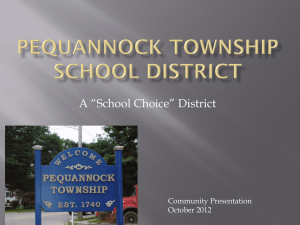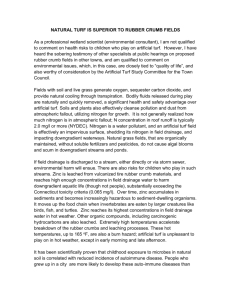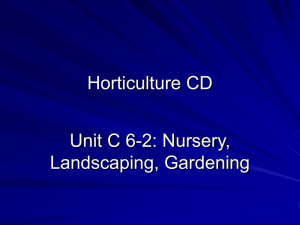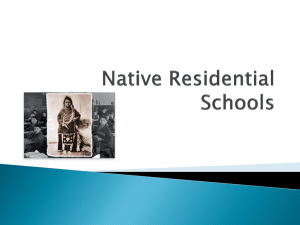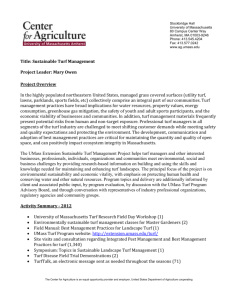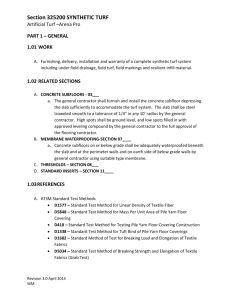Logic Model - National Water Program
advertisement
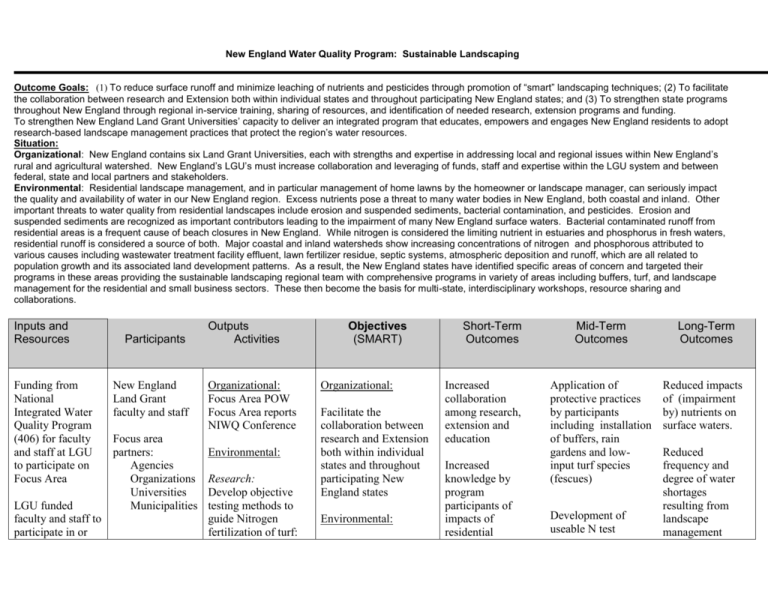
New England Water Quality Program: Sustainable Landscaping Outcome Goals: (1) To reduce surface runoff and minimize leaching of nutrients and pesticides through promotion of “smart” landscaping techniques; (2) To facilitate the collaboration between research and Extension both within individual states and throughout participating New England states; and (3) To strengthen state programs throughout New England through regional in-service training, sharing of resources, and identification of needed research, extension programs and funding. To strengthen New England Land Grant Universities’ capacity to deliver an integrated program that educates, empowers and engages New England residents to adopt research-based landscape management practices that protect the region’s water resources. Situation: Organizational: New England contains six Land Grant Universities, each with strengths and expertise in addressing local and regional issues within New England’s rural and agricultural watershed. New England’s LGU’s must increase collaboration and leveraging of funds, staff and expertise within the LGU system and between federal, state and local partners and stakeholders. Environmental: Residential landscape management, and in particular management of home lawns by the homeowner or landscape manager, can seriously impact the quality and availability of water in our New England region. Excess nutrients pose a threat to many water bodies in New England, both coastal and inland. Other important threats to water quality from residential landscapes include erosion and suspended sediments, bacterial contamination, and pesticides. Erosion and suspended sediments are recognized as important contributors leading to the impairment of many New England surface waters. Bacterial contaminated runoff from residential areas is a frequent cause of beach closures in New England. While nitrogen is considered the limiting nutrient in estuaries and phosphorus in fresh waters, residential runoff is considered a source of both. Major coastal and inland watersheds show increasing concentrations of nitrogen and phosphorous attributed to various causes including wastewater treatment facility effluent, lawn fertilizer residue, septic systems, atmospheric deposition and runoff, which are all related to population growth and its associated land development patterns. As a result, the New England states have identified specific areas of concern and targeted their programs in these areas providing the sustainable landscaping regional team with comprehensive programs in variety of areas including buffers, turf, and landscape management for the residential and small business sectors. These then become the basis for multi-state, interdisciplinary workshops, resource sharing and collaborations. Inputs and Resources Funding from National Integrated Water Quality Program (406) for faculty and staff at LGU to participate on Focus Area LGU funded faculty and staff to participate in or Participants New England Land Grant faculty and staff Focus area partners: Agencies Organizations Universities Municipalities Outputs Activities Organizational: Focus Area POW Focus Area reports NIWQ Conference Environmental: Research: Develop objective testing methods to guide Nitrogen fertilization of turf: Objectives (SMART) Organizational: Facilitate the collaboration between research and Extension both within individual states and throughout participating New England states Environmental: Short-Term Outcomes Increased collaboration among research, extension and education Increased knowledge by program participants of impacts of residential Mid-Term Outcomes Application of protective practices by participants including installation of buffers, rain gardens and lowinput turf species (fescues) Development of useable N test Long-Term Outcomes Reduced impacts of (impairment by) nutrients on surface waters. Reduced frequency and degree of water shortages resulting from landscape management provide support services (CIT?)for Focus Group Leveraged funds for regional, state, and local programs (includes state, federal and industry funds) Master Gardeners and other community volunteers Office equipment and supplies Use of anionexchange membranes to predict nitrate leaching losses from lawns Research: Develop objective testing methods to guide Nitrogen fertilization of turf Use of reflectance Research use of low input turf species meters to estimate probability of Outreach: exceeding water quality standards Strengthen state in percolate programs throughout leachates from New England through lawns regional in-service training, sharing of Outreach: successful program methods and resources, Develop teaching and identification of tools, materials, information resources needed research, extension programs and and demonstration funding. sites (turf, buffers, rain gardens, Establish/strengthen sustainable inter-agency residential and relationships to enhance nonresidential state and regional landscapes, and program efforts bioengineered erosion control) for Develop, implement use in educating and evaluate regional residents, industry, residential turf businesses, other management program property managers, for residential local officials , and properties landscape management practices on water resources (quality and quantity) Increased understanding by program participants of best management practices to reduce impacts of nutrients on water quality (includes use of buffers, rain gardens, alternative turf species) Increased understanding by program participants of best management practices to reduce impacts of erosion and suspended sediments on water quality (includes use of buffers, erosion prevention and bioengineering control) Increased method for industry and homeowner use Elimination/reduction and/or appropriate use of fertilizers (nutrient application) by homeowners to reduce negative impact on water systems Use of low-input turf species (fescue) as alternative to traditional lawn and/or reduction of lawn area by participants Residents and local officials identify erosion prone shore lands. Increased use of bioengineering methods for erosion control shore line stabilization Use of a suite of low input landscape management practices by nonresidential urban/suburban property owners and practices Reduced impacts of (impairment by) suspended sediments on surface waters Reduced impacts of (impairment by) bacterial contamination of surface waters Reduced number of bacteria related swim advisories and beach closures community decisionmakers on practices to reduce nutrients in water resources Develop and expand program websites Develop educational modules, training manuals, fact sheets/brochures, guidebooks, watershed signs for state and regional use Facilitate national (recognition of work) through publication in referred journals technical/professional publications, and presentations at conferences Develop proposal to fund social marketing research to enrich program development and outcomes Secure resources through partnerships and external funding Develop, implement and evaluate programs for low input cost effective landscape management for nonresidential properties in urbanizing watersheds Develop bioengineering for erosion control methods applicable to New England lakes and rivers understanding by program participants of best management practices to reduce bacterial contamination impacts on water quality managers sources, to develop, test and implement novel approaches that reduce nutrient, sediment, bacterial impairments of surface waters in New England. Participate in national water quality conferences through presentations, workshops and posters
